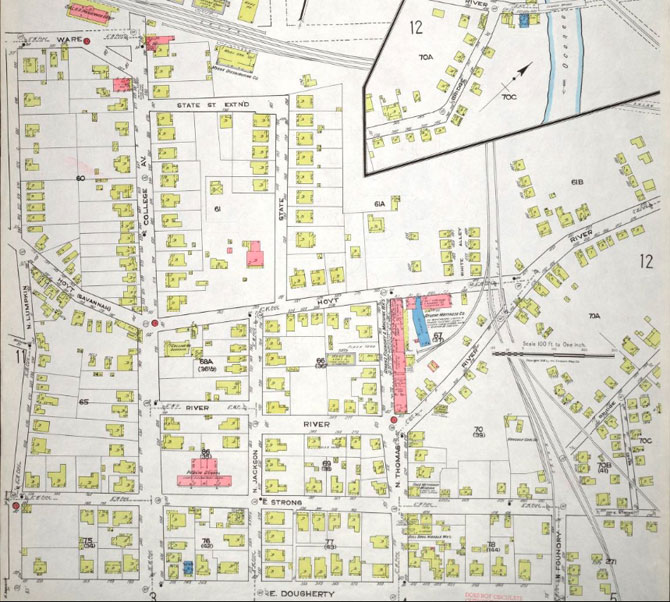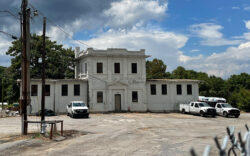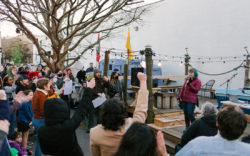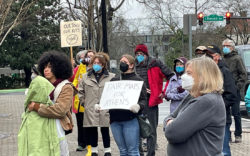An Athenian whisked away and dropped into north Athens 10 years from now probably won’t recognize where she is. The part of town stretching north from Dougherty Street out to the rail bridge across College Avenue will likely be radically transformed, even seeming rather continuous with downtown, instead of an afterthought spilling down the hill from where downtown unofficially ends.
The ambitious redevelopment of Bethel Midtown Village, affirmed by voters as part of the SPLOST 2020 package passed last month, is considered central to a larger overhaul of north Athens long envisioned by many. The nearly $40 million devoted to the redevelopment of Bethel, a formerly privately owned subsidized housing complex long neglected by its absentee landlord and beset by crime, will transform the substandard housing into a mixed-income, mixed-use neighborhood under the aegis of the Athens Housing Authority. The AHA will partner with outside for-profit companies to build and manage the new complex, which could also include nearby properties owned by AHA and Athens-Clarke County.
“There is a better day coming” for residents of Bethel, says Rick Parker, executive director of the AHA. Due to worsening physical conditions and poor reputation, nearly 40% of the complex’s units sit vacant. Commissioner Ovita Thornton, whose district includes Bethel, has spent over a decade working with residents and has watched the further degradation of the almost 50-year-old apartments. Thornton describes increasingly unlivable conditions and crime that has resisted all attempts at mitigation. “It could not continue the way it was deteriorating, period,” she says, going so far as to say that condemnation was a possibility had the property continued its decline. Bethel is “raggedy,” complains resident Tykerra Lattimore. “I’m ready for them to knock it down.”
“It’s going to make people feel good about coming home,” says Thornton of the apartments planned to replace Bethel. Parker explains the AHA’s commitment to a “total transformation” of the neighborhood, revealing that the agency had secured funding to dedicate about $70,000 per unit to renovations in the event of SPLOST not passing. The addition of SPLOST funds means that the aging structures will be entirely replaced with brand new buildings, roughly tripling the number of units and allowing an exploration of mixed-use (retail and/or office space) options on the 12-acre site. The new infrastructure built to service the site will likely have what Parker calls “multiplier effects” that spur development around and beyond the site itself.
Always in the Way
Such ambitions worry some tenants and observers who fear that there won’t be a place for Bethel residents in the new arrangement, but Parker makes clear the AHA’s commitment to the right of Bethel residents to return to the new development, should they choose. Parker and Tim Johnson of the nonprofit Family Connection/Communities in Schools assured stakeholders at an October meeting that the project will follow the principles of the Columbia Brookside redevelopment, when Jack R. Wells Homes—or “Pauldoe”—residents were given “first dibs” on units after the rebuild. Returning residents were even able to choose the exact apartment they preferred. As with Columbia Brookside, there will be no screening of residents upon returning, Parker says, with only a criminal conviction in the intervening period barring return.
Parker assures returning residents, too, that their rent will not change, “no matter what.” In the event of temporary displacement during construction, Bethel residents will be moved at the AHA’s expense, Parker vows, with even utility and cable hook-up costs being covered. “No resident will be out a dime,” he says.
Some residents are skeptical. “I don’t trust them,” says Bethel resident Carderious Gresham, who sees the proposal as a land grab. Fellow resident David Richards agrees that the project is little more than a way to expand downtown for students. The two do not expect that they will have a place in whatever replaces their home. The two also share a pride and love for “The Bricks,” as they refer to their home. “We don’t want The Bricks to go,” they lament.
While Richards and Gresham see calculated acquisition and eventual expulsion, not unlike a colonial maneuver in miniature, others worry that a sort of clumsiness of the powerful might damage vulnerable communities. Clarke County Board of Education President LaKeisha Gantt warns of the “unintended consequences” of these sorts of projects. Gantt, who grew up in Pauldoe and has friends and family in its replacement, Columbia Brookside, is optimistic about the prospects for Bethel residents but remains skeptical that the project will fulfill the lofty promises of its boosters. Even Thornton, a longtime advocate for better conditions at Bethel, echoes Gantt’s worry about potential “unforeseen” consequences. Skepticism abounds, especially in the African American community; it’s just a matter of whether the potential accrual of white property and power is another predictable unintended consequence or was always the express plan.
Indeed, for more than a century, the black neighborhood of north Athens, while vital to the prosperity of Athens and its university, has been considered by those same parties to be in the way, an obstruction to growth. This unfair relationship has been a feature of downtown’s periphery since emancipation, when freed slaves settled along the river and eventually established the neighborhoods of Lickskillet and The Bottom, stretching from the river around the top of downtown to North Lumpkin Street. For the next 150 years, black neighborhoods that ringed downtown and bounded parts of campus suffered the humiliation of propping up the white wealth of the city and campus while being considered a blight and a hinderance.
The neighborhood in north Athens thrived, however. Eventually, more than 300 homes, restaurants, groceries, barbershops and barrooms lined the streets and alleys north of downtown. As early as 1874, local papers reported on a black community in Lickskillet, sometimes described as the area around College Avenue and sometimes as the cluster around North Avenue and the river. At some point near the mid-20th Century, residents took to calling their neighborhood around College Avenue The Bottom.

This 1918 map shows how different the north side of downtown looked prior to Urban Renewal. Bethel is located at what was then the corner of Strong Street and College Avenue, while the train depot is in red at the top of the map. Several streets are now gone, and construction of the federal building pushed Dougherty north to connect with River Street, now known as North Avenue.
Charles Knox grew up in The Bottom and remembers a thriving black community of hard workers and entrepreneurs. He remembers that Neal “Big Daddy” Pattman, the “one-armed bluesman,” moved to The Bottom and operated a café there. Many in The Bottom did the hard work that white Athenians felt too onerous, keeping the homes of white women and building the wealth of white men.
But they were in the way. Northward was always the natural growth pattern for downtown. Downtown was, at one point, only Broad and Clayton streets. Blocks were added with time, and when the passenger train depot was eventually built, College Avenue was extended to connect it with the university and downtown. The river and its inhospitable terrain precluded growth to downtown’s east. Campus formed the southern edge. The west of downtown would have been more viable were it not for what a mid-20th Century report would call the “inharmonious” nature of a “densely populated non-white residential section and various public housing projects which have tended to effectively block orderly expansion in that direction.”
Downtown Athens, with continued growth, was imagined to be able to continue along the length of College Avenue. But there was the particular geography designed by white Athens, establishing that every concentration of white wealth—whether residential neighborhoods, the university or downtown—had appended to it or nearby a population of people whose hard work undergirded the wealth. White Athens seemed to want black work everywhere and black life nowhere. And by the early 20th Century, one such black neighborhood, considered a “slum,” sat directly between the train station—how most visitors and students arrived—and campus and downtown.
This reportedly caused no small amount of embarrassment. The station and its environs “gave no indication of the calm beauty of the campus or the stateliness of Milledge and Prince,” reflected William Tate on his 1920 arrival in Athens as a freshman, described in his Strolls Around Athens. Tate—who later became dean of students and the Tate Center’s namesake— and other students and visitors “trudged up” College Avenue amidst the “shacks and dingy houses” to reach campus. “Welcome, tourists and visitors, to Athens, the metropolis of northeast Georgia,” announced the Athens Daily Herald in 1915, immediately following an article titled “The Sty Makes the Pig,” about the “menace of the slums.” The “solution” is simple, said the Herald: “Permit no shacks.”
Another Displacement?
The opportunity to remove the “shacks” would come in the early 1960s with Urban Renewal. What may have begun as well-meaning, if paternalistic, initiatives from Washington to “revitalize” urban centers and replace decrepit housing stock with modern dwellings became, especially in the South, the sudden leeway to unilaterally clear away entire black communities at will. “Athens took advantage of the federal government’s urban renewal program when it was relatively new,” reported the Athens Daily News at the time.
Quite suddenly, sections of town long considered in the way of white expansion were subject to summary razing, with all the power of the federal, state and local government behind it. “They just came in and told us that they were going to tear the houses down,” remembers Knox, who was a child when his neighborhood was destroyed. “We were pushed out. There was no recognition, there was nothing. We just had to find somewhere to go.”
Around 375 structures were removed and perhaps as many as 1,000 people or more were “relocated” by the government out of Project #51, the name given to the roughly 100-acre zone. “Where slum houses once were a decided blight to the streets of north Athens large areas of open, unoccupied land now lie,” celebrated a local paper after the removal of black north Athens.
The city commissioned a report to best exploit the gift of Urban Renewal. The report “recommend[ed] that no public housing be built in the project area.” This was the mistake made west of downtown, the report concluded, where public housing like Parkview Homes consumed valuable real estate. “The project area is critical to downtown Athens and its expansion,” the report continued, stressing that non-white neighborhoods and public housing would foreclose on downtown’s growth northward. The removal of black families must be permanent, in other words. In other contexts, this is referred to as ethnic cleansing.
But public housing, of a sort, was built. Bethel finally opened in 1971 as a privately owned complex but operating, in effect, as Section 8 public housing, with tenants’ rent largely paid by the Department of Housing and Urban Development. What distinguished Bethel from its government-owned counterparts was the chronic neglect it suffered from its absentee landlords. The two out-of-town companies who have managed the property over the years did pitifully little to maintain the complex, and it has been roundly regarded as inferior to properties owned and overseen by the Athens Housing Authority. The area in and around Bethel gained a reputation for being dangerous—I was held up across College Avenue one night in the early 2000s and witnessed a shootout while reporting this story—and Bethel most likely did form something of a barrier to expansion northward.
The Bethel redevelopment will “unlock the potential of the north side of downtown,” says Parker, but unlike the desires of earlier generations of city planners, every Bethel resident will be allowed to come back and enjoy vastly better living conditions at no additional cost. The project’s proponents describe a win-win, not a zero sum. Bethel residents, they say, will be beneficiaries, not victims, integrated into a new and better north Athens, with market-rate units neighboring subsidized ones. In the most optimistic telling, north Athens could be the most genuinely diverse neighborhood in Athens.
Parker hopes to duplicate the success of Columbia Brookside, an award-winning redevelopment that even skeptics of the process admire. “If they do it like they did Pauldoe, it’ll be a good thing,” says Knox, who remains suspicious of the local government after his experience in The Bottom. Gantt calls Columbia Brookside “beautiful.”
But that is where the optimism should end. “I feel like there’s this ill-informed myth that if you diversify a neighborhood by income, then that is going to change the problems that a low-income family is dealing with,” says Gantt. “I feel that, in some ways, we’re hoping that this addresses an affordable housing issue that is actually rooted in wages and oppression.” Thornton concedes that the redevelopment, while greatly improving living conditions, “will not create wealth.”
The affordable housing crisis in Athens is downstream from the central and seemingly intractable predicament of the city: our inability to host a transient student population without suffering permanent poverty and general economic precarity. Some significant amount of poverty and low-wage, low-salary work appears to be built into the contemporary college town. It’s a bit like the old Soviet monotowns, with the entire population subordinated to a single industry. Ours is the immiserating work of producing upwardly mobile college graduates. No amount of affordable housing can alter what is a structural issue that apparently demands widespread poverty.
Bethel resident Gresham’s eyes widen when told the figure for the project’s cost. He proposes something at once preposterous and perfectly sensible: Why isn’t an allotment of money just split among residents to invest in homes, start businesses and make a clean break with the intergenerational trap of poverty? Gantt, too, wonders why investment in the people themselves can’t be part of these initiatives. (The short answer is that SPLOST can only pay for things like buildings and infrastructure, not social services.) Thornton floats the idea of coordinating various agencies and nongovernmental organizations, like Habitat for Humanity and others, to make home ownership a goal alongside refurbishing places like Bethel.
Gresham struggles as a father of three children, and all he knows is he’s losing the place he calls home. “Help us rebuild us,” he says.
Like what you just read? Support Flagpole by making a donation today. Every dollar you give helps fund our ongoing mission to provide Athens with quality, independent journalism.










